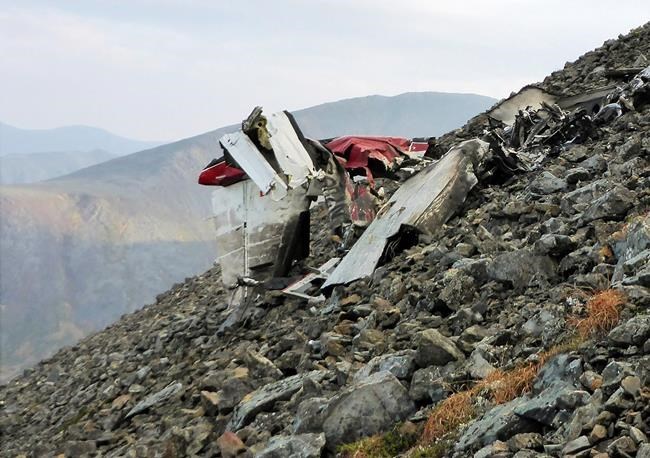
This Oct. 2, 2016 photo from Alaska State Troopers shows the scene of a fatal commuter plane crash on a mountainside near the village of Togiak, Alaska. The National Transportation Safety Board says the probable cause of the crash was the flight crew's decision to continue using visual flight rules as weather deteriorated between two villages. The October 2016 crash killed two Hageland Aviation Services pilots and a passenger on a scheduled flight in southwest Alaska. (Alaska State Troopers via AP)
April 10, 2018 - 3:59 PM
ANCHORAGE, Alaska - The probable cause of a fatal Alaska commuter airplane crash was the crew's decision to not seek an escape route under visual flight rules as weather deteriorated between two villages, the National Transportation Safety Board concluded Wednesday.
The board, meeting in Washington, D.C., also said inadequate training contributed to the crash of the Hageland Aviation Services aircraft, flying as Ravn Connect, on a mountainside 10 miles (16 kilometres) northwest of Togiak in southwest Alaska.
The Oct. 2, 2016, crash killed Timothy Cline, 43, and Drew Welty, 29, the pilots, and Louie John, 49, a passenger.
The turbine-powered Cessna 208B Grand Caravan left Quinhagak for a 60-mile (95-kilometre) late morning flight to Togiak. A second company plane followed five minutes later.
As weather deteriorated, the first plane continued on its planned, shorter route. Investigators found propeller scrape marks on the side of a mountain about 200 feet (61 metres) below the peak and said the aircraft may have been in a steep climb. The airplane continued over a ridge and crashed on the other side.
The crew of the second airplane reacted to the thickening clouds, diverted south over lower terrain and landed safety in Togiak.
The NTSB concluded that the probable cause of the crash was the first crew's failure to perform an immediate escape manoeuvr after entry into instrument conditions, which resulted in a "controlled flight into terrain."
The NTSB in August conducted an investigative hearing in Anchorage to focus attention on CFIT crashes in Alaska. NTSB had investigated five other Hageland accidents from December 2012 through April 2014.
Hageland policies and training contributed to the accident, the board said. Pilots routinely were allowed to turn on an "inhibit" switch for the airplane's Terrain Awareness and Warning System. The system emits loud warnings when airplanes are within 700 feet (213 metres) of terrain.
However, rural pilots under flight rules routinely fly as low as 500 feet (152 metres) and the warning system on the fatal flight would have constantly emitted the piercing sounds if not been inhibited. The crew of the second airplane had inhibited its system.
"I don't think these pilots really had a choice, if they were going to fly at that altitude, without going crazy and listening to that thing and being horribly distracting," said NTSB Chairman Robert Sumwalt. "They had to inhibit it,"
Hageland's CFIT-avoidance ground training, the board said, was not tailored to flying low in mountainous terrain. Its flight simulator lacked realistic cues and a TAWS system to let pilots practice responding to actual TAWS alerts.
It also said Hageland had not adequately addressed decision-making, including the division of duties among the crew.
Ravn Alaska, Hageland's parent company, did not immediately respond to requests for comment Tuesday.
At the August hearing, Luke Hickerson, Hageland's director of operations, said company pilots would prefer to fly every route with instrument flight rules. However, instrument rules require certified weather information and at least two-thirds of Hageland's routes are to communities lacking that infrastructure.
News from © The Associated Press, 2018